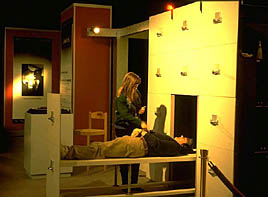![]()
PARTICIPATION: Ron M. Davis
Participatory Performances and Experiences
I have since my college days been intrigued by the potential of interactive and participatory performance. In 1983 I began an eleven-year relationship with Antenna Theater. Working with its founder and Artistic Director Chris Hardman, we explored several permutations of the audience interactive experience over the course of many projects; from the intimate interactive maze to large-scale group experiences. Most of Antenna's shows put the audience in stereo headphones, both to isolate them from each other as well as to put them at the center of elaborate sonic spaces. In headphones the voices one hears seem to emanate from within one's own head. The narrator navigates you with almost subliminal power.
Pieces such as IDLE/IDOL and Radio Interference were created using the "Carnival Midway" format; a large environment with several simultaneous interactive events of 5 to 10 minute duration. It is up to the viewer which, if any, event he or she chooses to experience and in what order. This carnival format is the most social of interactive formats. It allows for a mix of experiences, individually, in pairs or groups of a dozen or more hearing simultaneous audio. By employing headphones to drive the events, the
experience is not fully revealed until you directly participate. By having the events largely visible to the waiting audience or to non-participating members, it both intrigues as well as disarms any "performance anxiety" (serving alcohol as part of the evenings refreshments also helps).
 The
"interactive maze" provides for a more intimate experience, one in which isolation
can serve the storyline. The Etiquette of the Undercaste was a portable
interactive maze in which audience members entered in timed intervals. Lyingon
a morgue drawer-like slab, an attendant rolled each participant into the front
wall of the installation. While still lying flat on their backs they experienced
an ambulance ride, a hospital emergency room
The
"interactive maze" provides for a more intimate experience, one in which isolation
can serve the storyline. The Etiquette of the Undercaste was a portable
interactive maze in which audience members entered in timed intervals. Lyingon
a morgue drawer-like slab, an attendant rolled each participant into the front
wall of the installation. While still lying flat on their backs they experienced
an ambulance ride, a hospital emergency room
operating table on which they "die", then total darkness in which they hear the dirt shoveled onto their coffin; end of the first sequence. The narrator on the tape instructs them to stand up and go through the curtain, walk up a ramp into heaven, gaze down on a spinning globe/roulette wheel and then to be "reborn" by sliding down into a new life. On it goes until eventually the "audient" dies on a park bench, then exits the maze three feet from where they entered, having completed a life cycle.
I have put some of these tools to use in the museum environment, creating a ten-minute immersion theater for the California Academy of Science's EARTHQUAKE THEATER. For this permanent exhibit I tried to anticipate audience reactions, and to interject increasingly "in your face" elements to create some of the palpable sense of anxiety that real earthquakes can cause, without actually endangering anyone. What begins as a video presentation with a shaking floor at key moments, becomes a full panoramic view of swaying building complete with flame effects, smoke machines and falling scenery. The
program resumes with the video conclusion complete with all the cautionary platitudes about "preparation". As the lights begin to fade up and the audience prepares to exit, an "aftershock" seem to strike the theater itself, sending the overhead lights swaying, and increasing the sense of this being more than a staged exhibit. In this instance a little shaking goes a lot farther, and the element of surprise remains intact.
All of these events rely on anticipating the expectations of the audience. The size of the space, the dimness of the environment, the angle of the walls, even the presence of certain smells can sharpen the audience's sense that they are more than observers. Clarity of the audio directions within an event can eliminate confusion, or controlled confusion can create the dramatic effect that puts the audience at the emotional center of events.
Ron M. Davis is an art director and exhibit designer. He can be reached at <RonMDavis@aol.com>
| | TeleCircus | SpoonLife | pARTy/SCIENCE | Anon Salon |Audience Experience | |
| | Feedback | Contact: Mark "Spoonman" Petrakis | |